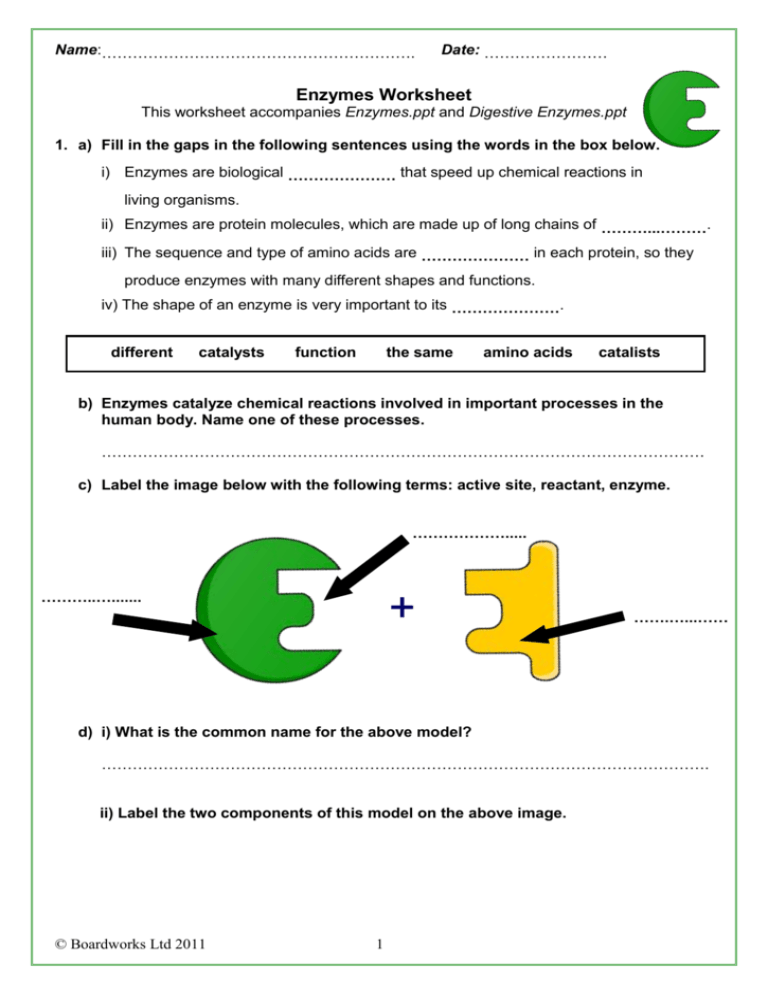Enzymes Worksheet
advertisement

Name:……………………………………………………. Date: …………………… Enzymes Worksheet This worksheet accompanies Enzymes.ppt and Digestive Enzymes.ppt 1. a) Fill in the gaps in the following sentences using the words in the box below. i) Enzymes are biological ………………… that speed up chemical reactions in living organisms. ii) Enzymes are protein molecules, which are made up of long chains of ………...………. iii) The sequence and type of amino acids are ………………… in each protein, so they produce enzymes with many different shapes and functions. iv) The shape of an enzyme is very important to its …………………. different catalysts function the same amino acids catalists b) Enzymes catalyze chemical reactions involved in important processes in the human body. Name one of these processes. ……………………………………………………………………………………………………… c) Label the image below with the following terms: active site, reactant, enzyme. ………………..... ………..…....... + …….…...…… ….............. d) i) What is the common name for the above model? ………………………………………………………………………………………………………. ii) Label the two components of this model on the above image. © Boardworks Ltd 2011 1 Name:……………………………………………………. Date: …………………… 2. a) Explain what would happen if a reactant molecule with a different shape to the enzyme came into contact with the enzyme’s active site. ……………………………………………………………………………………………………… ……………………………………………………………………………………………………… ……………………………………………………………………………………………………… b) Explain what would happen to a reactant molecule if it came into contact with an enzyme’s active site that matched its specific shape. Use the space below to draw and explain what would happen. Use the following terms in your answer: enzymereactant complex, products, enzyme, reactant, active site. c) There are many factors that affect the rate of enzyme-catalyzed reactions, including temperature. Name two other factors. ……………………………………………………………………………………………………… ………………………………………………………………………………………………… © Boardworks Ltd 2011 2 Name:……………………………………………………. Date: …………………… d) i) What would happen to an enzyme if the temperature and pH changed significantly beyond the enzyme’s optimum level? ……………………………………………………………………………………..…………... ii) How would this affect enzyme activity? ……………………………………………………………..…………………..…….………… …………………………………………………………………………………..………….……….. 3. A group of students decided to carry out an investigation to find out how enzyme activity is affected by temperature changes. They put samples of salivary amylase and starch into two test tubes. Salivary amylase is an enzyme that breaks down starch into maltose. Its optimum temperature for activity is around 37°C. a) What do you think happened to the rate of reaction when they increased the temperature of the first test tube to 37°C? …………………………………………………………………………………………………..….…... b) What do you think happened to the enzyme activity when the students decreased the temperature of the second test tube to O°C? ................................................................................................................................................... c) Explain what an inhibitor is and what it does. …………………………………………………………………………………………………………… ……………………………………………………………………………………………….………….. 4. a) Fill in the missing words in the following text about enzymes and digestion. Not all enzymes work inside cells in the body. ………………… enzymes are produced by specialized cells in the pancreas and digestive tract. From there, the enzymes pass out of the cells, into the ………………… and small intestine where they come into contact with food molecules. Here, they catalyze the ………………… of large molecules, which are then more easily absorbed by the body. b) Write down the name of the nutrient next to the enzyme that breaks it down. Use the words in the box below. © Boardworks Ltd 2011 3 Name:……………………………………………………. Date: …………………… i) Carbohydrase is an enzyme that breaks down ……………………… ii) Protease is an enzyme that breaks down ……………………… iii) Lipase is an enzyme that breaks down ……………………… iv) Amylase is an enzyme that breaks down ……………………… fats sucrose starch proteins carbohydrates hydrochloric acid c) The stomach produces hydrochloric acid which increases the acidity of the stomach to the optimum pH for stomach enzymes to digest the food. However, digestive enzymes found in the small intestine are damaged by strongly acidic conditions. How does the body avoid damaging the digestive enzymes in the small intestine with this strongly acidic pH as the food passes out of the stomach? …………………………………………………………………………………… …………………………………………………………………………………… …………………………………………………………………………………… …………………………………………………………………………………… …………………………………………………………………………………... 5. a) Biological washing powders contain protein-, fat- and carbohydrate-digesting enzymes to help remove stains. Name one other use for enzymes in the home or industry. ………………………………………………………………………………………………………… b) Give one advantage of using enzymes in industrial manufacturing processes. ………………………………………………………………………………………………………… ………………………………………………………………………………………………………… © Boardworks Ltd 2011 4







